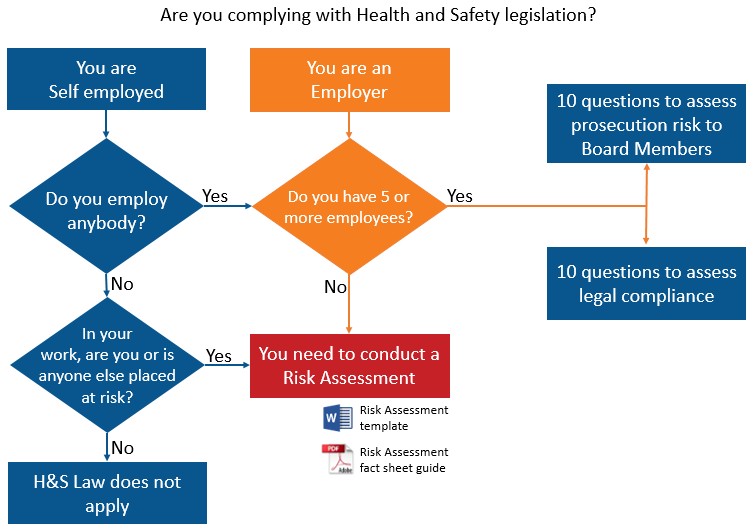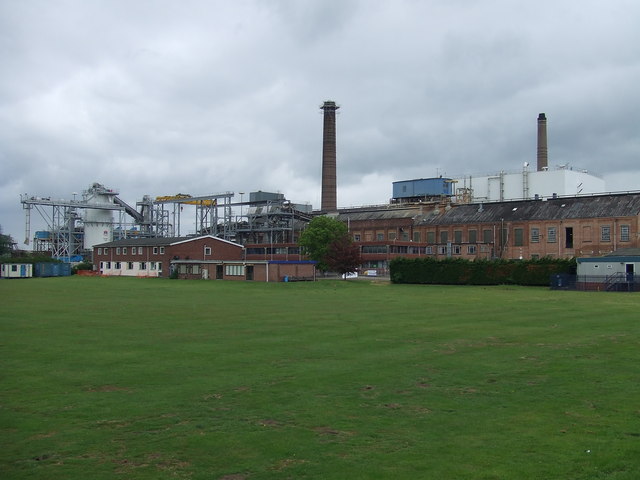Who needs health & safety?
The simple flow chart on the right is one way of answering this question.
Companies with 5 or more employees are legally obliged to ensure they comply with health and safety regulation. The next section of this page has 10 questions aimed at the Company Board. And rather than yes or no questions these are designed to get you thinking about the way you manage health and safety today. The following section of this page deals specifically with the prosecution risk for Board Members and ends with the 10 questions you need to answer.
If a board member decides they are not comfortable with the answers provided then you probably need a professional health and safety consultant to carry out an audit and assessment of your company's health and safety arrangements.
Self-employed people who do not employ anybody themselves, and whose work does not put themselves or anybody else at risk, do not need to worry about health and safety legislation. As of October 1st 2015 health and safety legislation no longer applies to them.
For self-employed people or companies who employ less than 5 people the legislation calls for a risk assessment to be carried out. If you are an individuals or work for a company that falls under this group, you should download a risk assessment fact sheet and a risk assessment template, and use these to ensure you fully comply with health and safety legislation with no additional outside support.

The Company Board is responsible for Health and Safety
If a health and safety offence is committed then individual board members (as well as the organisation) can be prosecuted under the Health and Safety at Work Act 1974.
Recent case law has confirmed that directors cannot avoid a charge of neglect by arranging their organisation’s business so as to leave them ignorant of circumstances which would trigger their obligation to address health and safety breaches.
Those found guilty are liable for fines and, in some cases, imprisonment. In addition, the Company Directors Disqualification Act 1986 empowers the court to disqualify an individual convicted of an offence in connection with the management of a company. Including health and safety offences. This power is exercised at the discretion of the court; it requires no additional investigation or evidence.
Individual directors are also potentially liable for other related offences, such as the common law offence of gross negligence manslaughter. Under the common law, gross negligence manslaughter is proved when individual officers of a company (directors or business owners) by their own grossly negligent behaviour cause death. This offence is punishable by a maximum of life imprisonment.
10 questions for Your Company Board of Directors
The following ten questions will help a company board understand how well they are managing health and safety today:
- How do you demonstrate the board’s commitment to health and safety?
- What do you do to ensure appropriate board level review of health and safety?
- What have you done to ensure your organisation, at all levels including the board, receives competent health and safety advice?
- How are you ensuring all staff – including the board – are sufficiently trained and competent in their health and safety responsibilities?
- How confident are you that your workforce, particularly safety representatives, are consulted properly on health and safety matters, and that their concerns are reaching the appropriate level including, as necessary, the board?
- What systems are in place to ensure your organisation’s risks are assessed, and that sensible control measures are established and maintained?
- How well do you know what is happening on the ground, and what audits or assessments are undertaken to inform you about what your organisation and contractors actually do?
- What information does the board receive regularly about health and safety, e.g. performance data and reports on injuries and work related ill health?
- What targets have you set to improve health and safety and do you benchmark your performance against others in your sector or beyond?
- Where changes in working arrangements have significant implications for health and safety, how are these brought to the attention of the board?


British Sugar case study
- The chief executive assigning health and safety responsibilities to all directors
- Monthly reports on health and safety going to the board
- More effective working partnerships with employees, trade unions and others
- Overseeing an audited behavioural change programme
- Publishing annual health and safety targets and initiatives to meet them
- 43% drop in time lost to injuries over two years;
- 63% reduction in major health and safety issues in one year;
- Much greater understanding among directors of health and safety risks
Health and Safety – The day to day legal requirements
Day to day management of health and safety
Do you have arrangements for dealing with workplace incidents and accidents?
Answer: Inevitably, no matter how good the control measures, accidents and incidents (near misses) do occur from time to time. When they do it is important to document what happened and to decide whether new control measures are needed to prevent them from reoccurring.For more information download the fact sheet on accident reporting.
Do you consult with employees about their risks at work and current preventive and protective measures?
Answer: Risk management is the responsibility of everyone in the company. The direction needs to come from senior management but all staff need to be engaged through a consultation process that gives everyone an opportunity to share their experience about the hazards and risks they face in their day to day activities.
Have you provided your employees with information about the risks in your workplace and how they are protected, and have you provided adequate supervision, instruction and training for employees in how to deal with the risks?
Answer: Finally, having decided on the risks and how they will be managed you need to communicate this to your staff and provide the appropriate training and protective equipment so that risks can be reduced to a manageable level.
Have you made arrangements for the effective planning, organisation, control, monitoring and review of the preventive and protective measures that came from the risk assessments?
Answer: Simply documenting the identified risks is not enough. For significant risks you need to implement and monitor control measures that either eliminate or help offset or control the inherent risks of your activities.
Have you recorded the significant findings from these risk assessments?
Answer: You do not need to record all findings, only those that have either a reasonable chance of occurring and/or those that if they did occur might cause serious harm to staff or visitors. The focus should be on identifying hazards and controlling risk and not on producing a large volume of documentation.
In the last 24 months have you assessed all other risks to employees, contractors, customers, partners and any other people who could be affected by your activities?
Answer: Employers have a strict legal duty under the Management of Health and Safety at Work Regulations 1999 to identify key workplace hazards. The top two hazards that cause injury across all workplaces are manual lifting and slips, trips and falls.
For more information download the Health and Safety Risk Assessment fact sheet
Have you carried out a Fire Risk Assessment in the last 18 months?
Answer: Employers have a strict legal duty under the Management of Health and Safety at Work Regulations 1999 to identify key workplace hazards. The risk of fire is seen as particularly significant because of the potential for serious injury and loss of life. In the event of a fire one of the first questions that will be asked is how recently the last fire risk assessment was conducted.
For more information download the Fire Safety fact sheet
Do you have a written health and safety policy and has this been communicated to staff and contractors?
Answer: If you have five or more employees, you are required to have a written Health and Safety Policy. This must include a Statement of Health and Safety Intent, signed by the Managing Director or equivalent; details of the health and safety organisation and responsibilities; and the arrangements and procedures for managing health and safety risks applicable to your business.
For more information download the Health and Safety Policy fact sheet.
Does your nominated person provide or have access to competent health and safety advice?
Answer: It is a strict legal requirement under the Management of Health and Safety at Work Regulations 1999 for employers to appoint one or more health and safety competent persons to assist in managing safety and health risks. The competent person should have an understanding of company operations and be qualified proportionate to operational health and safety risks. The competent person may be appointed in-house or externally through the use of a competent person.
For more information download the Health and Safety Competent Person fact sheet.
Have you recorded the significant findings from these risk assessments?
Answer: You do not need to record all findings, only those that have either a reasonable chance of occurring and/or those that if they did occur might cause serious harm to staff or visitors. The focus should be on identifying hazards and controlling risk and not on producing a large volume of documentation.
In the last 24 months have you assessed all other risks to employees, contractors, customers, partners and any other people who could be affected by your activities?
Answer: Employers have a strict legal duty under the Management of Health and Safety at Work Regulations 1999 to identify key workplace hazards. The top two hazards that cause injury across all workplaces are manual lifting and slips, trips and falls.For more information download the Health and Safety Risk Assessment fact sheet.
Have you carried out a Fire Risk Assessment in the last 18 months?
Answer: Employers have a strict legal duty under the Management of Health and Safety at Work Regulations 1999 to identify key workplace hazards. The risk of fire is seen as particularly significant because of the potential for serious injury and loss of life. In the event of a fire one of the first questions that will be asked is how recently the last fire risk assessment was conducted.For more information download the Fire Safety fact sheet.
Do you have a written health and safety policy and has this been communicated to staff and contractors?
Answer: If you have five or more employees, you are required to have a written Health and Safety Policy. This must include a Statement of Health and Safety Intent, signed by the Managing Director or equivalent; details of the health and safety organisation and responsibilities; and the arrangements and procedures for managing health and safety risks applicable to your business.For more information download the Health and Safety Policy fact sheet.
Does your nominated person provide or have access to competent health and safety advice?
Answer: It is a strict legal requirement under the Management of Health and Safety at Work Regulations 1999 for employers to appoint one or more health and safety competent persons to assist in managing safety and health risks. The competent person should have an understanding of company operations and be qualified proportionate to operational health and safety risks. The competent person may be appointed in-house or externally through the use of a competent person, such as Arinite.For more information download the Health and Safety Competent Person fact sheet.
Have you nominated someone in your organisation to oversee health and safety?
Answer: The Health and Safety Executive supported by the Institute of Directors, recommend that senior management take a lead on health and safety and that a Board Member champion health and safety issues. This is formalised in a joint HSE-IoD document called “Leading Health and Safety at Work”. Although this is not a strict legal requirement, lawyers have said that this document could be cited as best practice in health and safety and corporate manslaughter prosecutions.For more information download the Health and Safety for Directors fact sheet.



